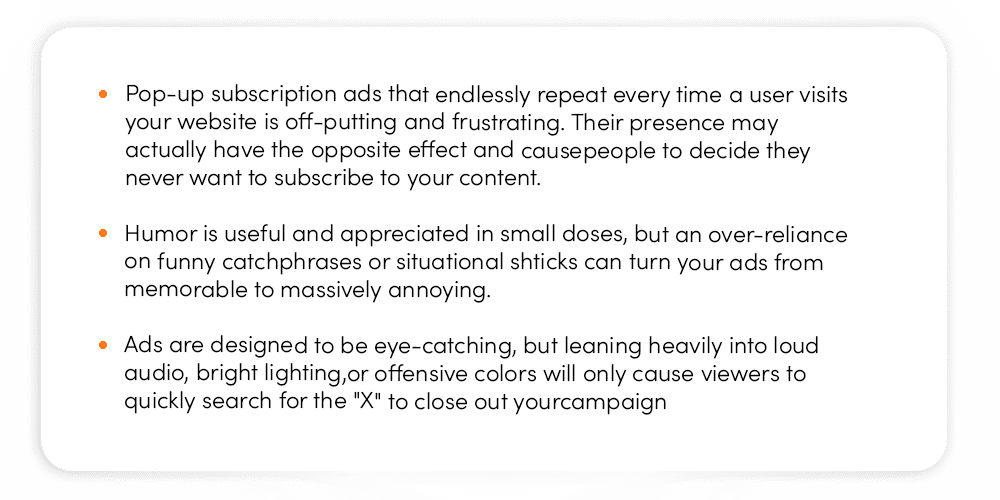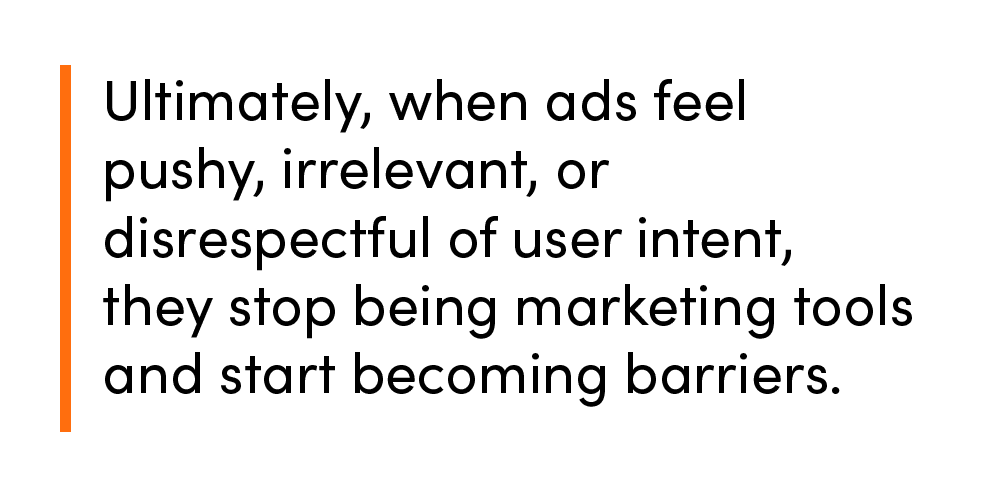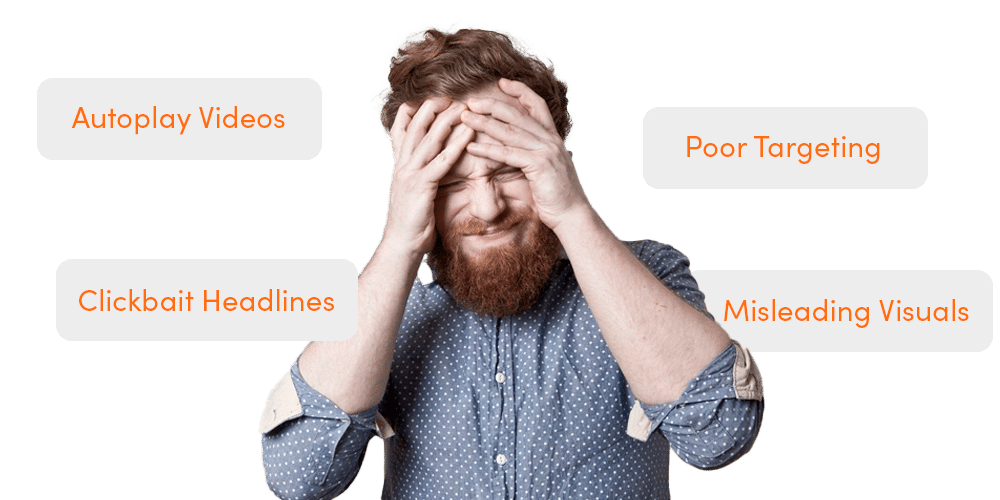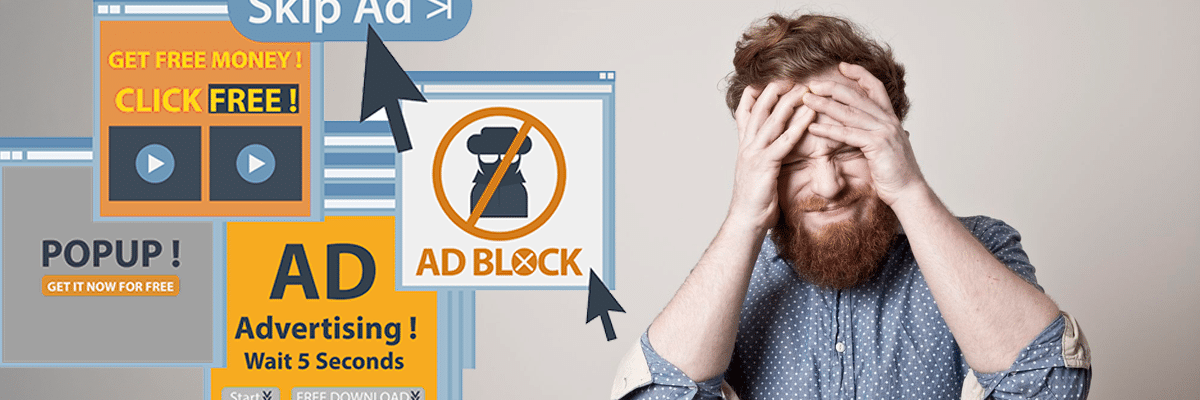Walking that fine line between timely messaging and annoying ads is tricky at best and profit-losing at worst. While we know there’s always a learning curve when testing and iterating ad campaigns, the absolute worst outcome is running irrelevant ads that create ad fatigue and alienate your consumer base. The trouble is, finding that fine line is near impossible if you don’t know three vital facts: what’s wrong, how to fix it, and what to do instead. Before your brand launches its next round of pop-up ads, autoplay videos, or homepage takeovers, use this guide to gain an advantage – not elicit annoyance – with your customers.
From Click to Quit: How Bad Ads Drive Customers Away
Pop-ups, autoplay videos, and full-page takeovers interrupt user flow and consistently rank among the most hated ad formats. In fact, intrusive ad formats do far more than damage brand perception and drive users closer to ad blockers yet further from your products; they’re also the #1 driver of consumer anger. The line between attention-grabbing and annoying is thin, and crossing it may win a brief glance, but it often costs you long-term trust.
These truths are important to safeguard your brand from demise, but the most intriguing component of this equation is the psychology behind these reactions. If you’re as curious about how and why ad annoyance happens, we understand. We’ve wondered the exact same thing. So, to satisfy our concern by spending a few moments getting meta about marketing. To better understand how annoying ads turn consumers off, we polled the staffers at (matter) for their opinions. Though perspectives differed among team members, a few overarching trends emerged:

Trust Is Fragile: The Long-Term Brand Consequences of Annoying Ads
Whether an audience is browsing your brand on desktop, mobile, music, social, or video platforms, they’re bound to encounter ad-supported content. Companies who don’t directly market to consumers within their own digital ecosystems are leaving money on the table, and shoppers know that the occasional pop-up comes with the e-commerce territory. But there’s a clear distinction between a one-time intrusive ad that offers helpful information and a video that just won’t stop loading, no matter how many times you close it.

Some consumers even pay to avoid ad overload, so when these intrusive messages continue to appear, their presence does nothing but severely break down their confidence in your company. And honestly, that makes sense.
Consumers have every right to feel betrayed when, even after opting or paying not to, they still see ads on paid subscription platforms like Amazon Prime or Crunchyroll. This overstep triggers a sense of “double-dipping” and overwhelms and frustrates users just as quickly as too many ads per page can. So how can your brand avoid intrusive advertising and keep customers coming back for more? By first understanding why specific ad types are turn-offs.
What Makes an Ad Annoying?

Thankfully, annoying ads share common characteristics that turn off consumers almost instantly, so avoiding them is fairly straightforward. Intrusive advertising like autoplay videos, irrelevant targeting, and bait-and-switch tactics frequently cause customer annoyance. Even if the intent of your marketing is to inform or entertain, relying on intrusive messaging will only aggravate. Here’s a closer look at the most annoying types of ads we hear about from our clients so you can be sure to steer clear:
Jarring autoplay videos: Ever scrolled a homepage with deep interest, only to be shocked out of concentration by a blaring song or pop-up video that blocks all content and is hard to close? Autoplay media that disrupts the user experience does nothing but for your brand but signal its blatant disregard for your audience’s time and attention.
Repetition: Another major offense that leads to ad fatigue is repetition. Yes, the brand exposure “Rule of 7” still applies, but seeing the same ad over and over – especially if it’s irrelevant or annoying – can breed frustration or even brand hostility.
Poor targeting: Imagine your ad for baby formula keeps appearing to someone without kids, or your pop-up announcing your women’s clothing sale shows up for male visitors, too. That’s not just ineffective marketing and wasted ad spend, it’s downright irritating and pushes people away.
Clickbait headlines: Overpromising with sensational or misleading titles only to underdeliver in-content is a quick way to turn people against your brand. Don’t promise a specific outcome, like a life-changing tip, if you’re not prepared to fully deliver relevant answers in the actual article or content.
Misleading visuals: Graphics departments can be just as guilty as content teams of tricking consumers into visiting a webpage. Relying on deceptive marketing materials like manipulated data, inappropriate chart types, or false imagery to gain web traffic will only serve to push consumers away from your brand.
Bait-and-switch: It’s not hard to see how bait-and-switch on any level would only add fuel to the annoyance fire. Today’s consumers are more ad-aware than ever and can smell manipulation a mile away, so these tactics erode trust fast.
Restructuring Your Ad Strategy: Better Alternatives for Annoyance-Free Advertising
Ready for a few real-world examples of engaging, ethical, user-friendly ads that build connection and value? Non-annoying messaging starts with respecting the user experience. Instead of hijacking attention with intrusive advertising, good ads aim to add value through entertainment, education, relevance, or a mixture of the three. In short, the best brands don’t just advertise to their audience; they build relationships with them. Follow this checklist to set your company on the path to annoyance-free ads:

Instead of bombarding users with generic or invasive messaging, deliver content that’s tailored to genuine interests or needs.

Using transparent opt-ins and promotions makes consumers feel in control of their time and valued for their business.

Aligning your pop-ups or autoplays with user-centric wants and needs is a smarter, more profitable alternative to blanket marketing and irrelevant ads.

Visual design matters just as much as messaging, so as you design your sponsored content, native ads, or short videos, blend them seamlessly into your digital landscape without interrupting its natural flow.

Messaging should avoid exaggeration or emotional manipulation. Instead, show your customers you understand their pain points and know how to fix them.

Ethical advertisers track more than clicks; they value metrics like customer satisfaction or brand sentiment to paint a more well-rounded picture of the long-term relationships they’re building with customers.
The Future of Ethical Advertising: The (matter) Approach
When ads are delivered with sincere intent, provide valuable or helpful information, and respect a viewer’s time and privacy, they don’t just avoid being annoying – they actually foster the connection, trust, and loyalty that every brand desperately needs. In the long run, ethical advertising that doesn’t deceive, mislead, or bait-and-switch aren’t just better for customers, they’re better for your business, too.
If data insights or your marketing instincts are telling you that consumers are turning away from your brand because of irrational ad anger, you can salvage your reputation and your bottom line with the trust-building power of (matter) ads. It may sound like an oversell, but in the same way your advertising should never overpromise and underdeliver, neither will we. Our agency’s motto is quite literally to market less and matter more, and when you partner with us, that’s exactly what you’ll receive: A strategic, non-disruptive ad campaign that’s as far from ad annoyance as you can get. Contact (matter) to get connected today.
